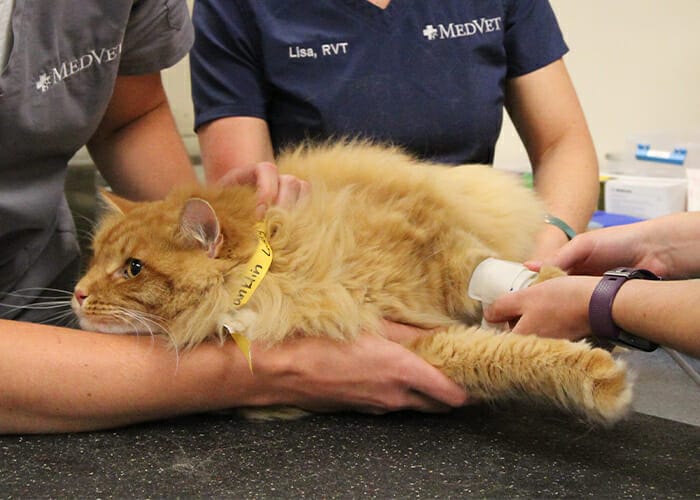
Many of us are familiar with asthma as a human disease and have seen inhalers used to help people with asthma breathe. What many do not realize is that asthma can also be a health issue for cats and if not treated, can become very serious and even fatal.
What is Asthma in Cats?
Asthma is an inflammation of the bronchioles, the small passages in a cat’s lungs in which the air should flow freely. Once the passages become swollen or are plugged with mucus, a cat will struggle to breathe. Their respiratory rate becomes faster, and they audibly wheeze as the airflow is restricted through their lungs. While asthma can begin at any age, most of the time cats begin to have signs as young adults.
What are the Signs of Asthma in Cats?
Cats with asthma may not show signs in the early stages of their condition. They may begin to breathe faster, even at rest. As the inflammation progresses in the lungs, they may cough to clear the passageways or their breathing can sound wheezy or like a whistle, as if they are trying to draw air through a narrow straw.
In an acute asthma attack, a cat may extend its neck and appear hunched, panting and their gums may appear blue. Cats that are struggling to breathe are very frightened and may hide or resist being picked up or touched.
Diagnosing Asthma in Cats
To diagnose asthma, veterinarians will take radiographs (X-rays) which usually have a characteristic pattern in the lung fields where inflammation in the airways is visible. Many veterinarians think the thickened edges of the bronchi look like railroad tracks or thick donuts.
Blood tests may also be done to check for an increase in certain types of white blood cells. Other tests that may be used include collecting fluid droplets from the airways in the lungs for analysis and bacterial culture.
It is important to rule out other diseases that can mimic asthma, such as heart disease, viral or bacterial infection, respiratory parasites, and foreign material in the respiratory tract, to ensure the correct medications or therapies are recommended

Treating Asthma in Cats
With an abrupt attack or if the early signs are not recognized, asthma can be fatal. However, the disease can be well managed through therapy that rapidly decreases the swelling in the airways.
When a cat is in severe respiratory distress, veterinarians will give a steroid injection to reduce inflammation quickly. While the steroids are working, cats are often hospitalized in cages with a high percentage of oxygen flowing into the cage, making it easier for them to breathe and keeping their blood oxygen levels normal.
Cats may also be treated with bronchodilators, medications that temporarily make the airways open and allow increased airflow. Albuterol, one type of bronchodilator used for humans and cats, can be given through a nebulizer or an inhaler.
An inhaler for a kitty? Yes! They can use an inhaler similar to what is used for small children – a face mask attached to a small spacer (which holds the medication in place), allowing the cat to breathe in the air slowly. Cats can become acclimated to wearing the face mask with treats, petting, and encouragement.
Many cats with asthma will need to take an oral steroid, such as prednisolone, for the remainder of their life. These steroids help reduce airway swelling and prevent it from getting dangerously swollen again. Side effects from steroids can include weight gain, excessive thirst, and the potential to trigger diabetes in cats. Your family veterinarian will monitor your cat’s lungs, weight, and lab work to minimize side effects and reduce the dose as much as possible while keeping it effective.
Vigilance is Key
No one knows why some cats are prone to asthma or if allergies or irritants can aggravate their breathing. We encourage cat owners to keep pets indoors and use dust-free litter. Cats with asthma should not be exposed to cigarette smoke, wood smoke, or any musty or poorly ventilated areas.
While asthma cannot be cured, it can be managed. Careful vigilance and a close partnership with your veterinarian are the best ways to prevent flare-ups. If your cat is struggling to breathe, you should contact your family veterinarian or your nearest MedVet.